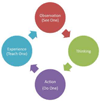Application of the "see one, do one, teach one" concept in surgical training
- PMID: 23629100
- PMCID: PMC4785880
- DOI: 10.1097/PRS.0b013e318287a0b3
Application of the "see one, do one, teach one" concept in surgical training
Abstract
Background: The traditional method of teaching in surgery is known as "see one, do one, teach one." However, many have argued that this method is no longer applicable, mainly because of concerns for patient safety. The purpose of this article is to show that the basis of the traditional teaching method is still valid in surgical training if it is combined with various adult learning principles.
Methods: The authors reviewed literature regarding the history of the formation of the surgical residency program, adult learning principles, mentoring, and medical simulation. The authors provide examples for how these learning techniques can be incorporated into a surgical resident training program.
Results: The surgical residency program created by Dr. William Halsted remained virtually unchanged until recently with reductions in resident work hours and changes to a competency-based training system. Such changes have reduced the teaching time between attending physicians and residents. Learning principles such as experience, observation, thinking, and action and deliberate practice can be used to train residents. Mentoring is also an important aspect in teaching surgical technique. The authors review the different types of simulators-standardized patients, virtual reality applications, and high-fidelity mannequin simulators-and the advantages and disadvantages of using them.
Conclusions: The traditional teaching method of "see one, do one, teach one" in surgical residency programs is simple but still applicable. It needs to evolve with current changes in the medical system to adequately train surgical residents and also provide patients with safe, evidence-based care.
Figures


References
-
- Qayumi K. Surgical skills lab: a hub for competency training. J Invest Surg. 2010;23:48–56. - PubMed
-
- Vozenilek J, Huff JS, Reznek M, Gordon JA. See one, do one, teach one: advanced technology in medical education. Acad Emerg Med. 2004;11:1149–1154. - PubMed
-
- Rohrich RJ. "See one, do one, teach one": an old adage with a new twist. Plast Reconstr Surg. 2006;118:257–258. - PubMed
-
- Mason WT, Strike PW. See one, do one, teach one--is this still how it works? A comparison of the medical and nursing professions in the teaching of practical procedures. Med Teach. 2003;25:664–666. - PubMed
Publication types
MeSH terms
Grants and funding
LinkOut - more resources
Full Text Sources
Other Literature Sources

